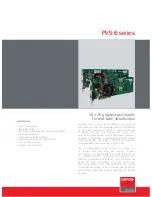
9. Error Handling > Other Errors
80
PEB383 User Manual
July 25, 2011
Integrated Device Technology, Inc.
Confidential - NDA Required
9.4.1
PCIe Completion Timeout Errors
The PCIe Completion Timeout function allows requestors to abort a non-posted request if the
completion does not arrive within a reasonable period of time. When bridges act as initiators on PCIe
on behalf of internally generated requests, and requests forwarded from a secondary interface in PCI
mode, they act as endpoints for requests that they take ownership. When the PEB383 detects a
completion timeout it responds as if a completion with Unsupported Request status has been received
and follows the rules for handling Unsupported Request Completions as described in
. In addition, the bridge takes the following actions:
1.
“PCIe Uncorrectable Error Status Register”
2.
Error Fatal or Non-Fatal message is generated on PCIe as per the severity level of the CTO bit in
“PCIe Uncorrectable Error Severity Register”
and either SERR_EN bit is set in
“PCI Control and Status Register”
or
FTL_ERR_EN/NFTL_ERR_EN bit is set in
“PCIe Device Control and Status Register”
3.
“PCI Control and Status Register”
if an error message (Fatal/Non-Fatal) is
generated and the SERR_EN bit is set in
“PCI Control and Status Register”
9.4.2
PCI Delayed Transaction Timeout Errors
If a delayed transaction timeout is detected the PEB383 does the following:
1.
Error Fatal or Non-Fatal message is generated on PCIe as per the severity level of DTDTE bit in
“PCIe Secondary Uncorrectable Error Severity Register”
, if DTDTE Mask bit is clear in
Secondary Uncorrectable Error Mask Register”
or DISCARD_SERR bit is set
Control and Interrupt Register”
and either SERR_EN bit is set in
or FTL_ERR_EN/NFTL_ERR_EN bit is set in
“PCIe Device Control and Status
2.
No Header is logged
3.
“PCI Control and Status Register”
if an error message (Fatal/Non-Fatal) is
generated and SERR_EN bit is set in
“PCI Control and Status Register”
9.5
Other Errors
PCI devices can assert SERR# when detecting errors that compromise system integrity. When the
PEB383 detects SERR# on the secondary interface, it does the following:
1.
“PCI Secondary Status and I/O Limit and Base Register”
2.
Error Fatal or Non-Fatal message is generated on PCIe as per the severity level of SERR_AD bit in
“PCIe Secondary Uncorrectable Error Severity Register”
if SERR_AD Mask bit is clear in
Secondary Uncorrectable Error Mask Register”
or SERR_EN bit is set in
and either SERR_EN bit is set in
“PCI Control and Status Register”
FTL_ERR_EN/NFTL_ERR_EN bit is set in
“PCIe Device Control and Status Register”
3.
SERR_AD bit is set in
“PCIe Secondary Uncorrectable Error Status Register”
4.
SUFEP field is updated in
“PCIe Secondary Error Capabilities and Control Register”
5.
No Header is Logged for SERR# assertion
















































